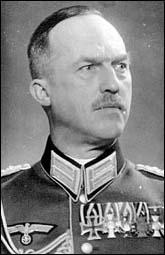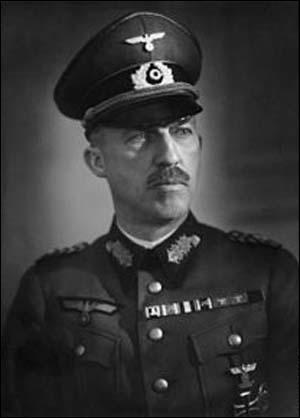Paul von Hase

Paul von Hase, the fifth child of Paul and Frieda von Hase, was born on 24th July, 1885. He was the uncle of Dietrich Bonhoeffer and Klaus Bonhoeffer. On 12th December 1921, Hase married Margarete, Baronesse von Funck in Neustreiltz. They had four children: Ina, Maria-Gisela, Alexander and Friedrich-Wilhelm. Dietrich Bonhoeffer said of Von Hase in February, 1933: "He's an unusually well-informed person, he's alert, open, sociable, affable, possesses independent judgment." (1)
Originally a supporter of Adolf Hitler in 1935 he was appointed Commander 50th Regiment. (2) In January 1938, Major-General Hase joined forces with Colonel-General Ludwig Beck, Admiral Wilhelm Canaris, General-Major Hans Oster, Colonel-General Erich Hoepner, Hans Gisevius, Carl Goerdeler, Arthur Nebe, Wolf-Heinrich Helldorf and Hjalmar Schacht, against the Gestapo. They believed that the SS was trying to take control of the German Army and Hase was prepared to use his regiment against the government in Berlin. However, the proposed coup never took place. (3)
1939 Hase became Commander of the 56th Division. The following year he became City commandant of Berlin. In January, 1942, a group of men that included Hase, Beck, Canaris, Oster, Nebe, Gisevius, Goerdeler, Helldorf, Schacht, Field Marshal Erwin von Witzleben, General Friedrich Olbricht, General Carl-Heinrich von Stülpnagel, General-Major Henning von Tresckow, General Erich Fellgiebel, General Lieutenant Karl Freiherr von Thüngen, Lieutenant Fabian Schlabrendorff, Major Hans Ulrich von Oertzen, Wilhelm Leuschner, Ulrich Hassell, Hans Dohnanyi, Carl Langbehn, Julius Leber, Helmuth von Moltke, Peter von Wartenburg, Johannes Popitz and Jakob Kaiser, decided to overthrow Adolf Hitler. The conspiracy was called Operation Valkyrie. (4)
During 1942, several senior military officers, joined the conspiracy. This included Field Marshal Günther von Kluge, Field Marshal Erwin Rommel, General Eduard Wagner, General Fritz Lindemann, Lieutenant-Colonel Claus von Stauffenberg, Lieutenant Werner von Haeften, Colonel Albrecht Metz von Quirnheim, General-Major Helmuth Stieff, and Colonel-General Erich Hoepner. "These generals, either because of their strength of numbers, their key positions for a revolt, or because of the recognition that the fate of the class was at stake, began to feel an increasing sense of unity." (5)

On 20th July, 1944, Claus von Stauffenberg and Werner von Haeften left Berlin to meet with Hitler at the Wolf' Lair. After a two-hour flight from Berlin, they landed at Rastenburg at 10.15. Stauffenberg had a briefing with Field Marshal Wilhelm Keitel, Chief of Armed Forces High Commandat, at 11.30, with the meeting with Hitler due to take place at 12.30. As soon as the meeting was over, Stauffenberg, met up with Haeften, who was carrying the two bombs in his briefcase. They then went into the toilet to set the time-fuses in the bombs. They only had time to prepare one bomb when they were interrupted by a junior officer who told them that the meeting with Hitler was about to start. Stauffenberg then made the fatal decision to place one of the bombs in his briefcase. "Had the second device, even without the charge being set, been placed in Stauffenberg's bag alone with the first, it would have been detonated by the explosion, more than doubling the effect. Almost certainly, in such an event, no one would have survived." (6)
When he entered the wooden briefing hut, twenty-four senior officers were in assembled around a huge map table on two heavy oak supports. Stauffenberg had to elbow his way forward a little in order to get near enough to the table and he had to place the briefcase so that it was in no one's way. Despite all his efforts, however, he could only get to the right-hand corner of the table. After a few minutes, Stauffenberg excused himself, saying that he had to take a telephone call from Berlin. There was continual coming and going during the briefing conferences and this did not raise any suspicions. (7)
Stauffenberg and Haeften went straight to a building about 200 hundred yards away consisting of bunkers and reinforced huts. Shortly afterwards, according to eyewitnesses: "A deafening crack shattered the midday quiet, and a bluish-yellow flame rocketed skyward... and a dark plume of smoke rose and hung in the air over the wreckage of the briefing barracks. Shards of glass, wood, and fiberboard swirled about, and scorched pieces of paper and insulation rained down." (8)
Stauffenberg and Haeften observed a body covered with Hitler's cloak being carried out of the briefing hut on a stretcher and assumed he had been killed. They got into a car but luckily the alarm had not yet been given when they reached Guard Post 1. The Lieutenant in charge, who had heard the blast, stopped the car and asked to see their papers. Stauffenberg who was given immediate respect with his mutilations suffered on the front-line and his aristocratic commanding exterior; said he must go to the airfield at once. After a short pause the Lieutenant let them go. (9)
According to eyewitness testimony and a subsequent investigation by the Gestapo, Stauffenberg's briefcase containing the bomb had been moved farther under the conference table in the last seconds before the explosion in order to provide additional room for the participants around the table. Consequently, the table acted as a partial shield, protecting Hitler from the full force of the blast, sparing him from serious injury of death. The stenographer Heinz Berger, died that afternoon, and three others, General Rudolf Schmundt, General Günther Korten, and Colonel Heinz Brandt did not recover from their wounds. Hitler's right arm was badly injured but he survived. (10)
Adolf Hitler, seized by a "titanic fury and an Unquenchable thirst for revenge" ordered Heinrich Himmler and Ernst Kaltenbrunner to arrest "every last person who had dared to plot against him". Hitler laid down the procedure for killing them: "This time the criminals will be given short shrift. No military tribunals. We'll hail them before the People's Court. No long speeches from them. The court will act with lightning speed. And two hours after the sentence it will be carried out. By hanging - without mercy." (11)
The first trial, held on 7th August, 1944, resulted in the conviction of General Paul von Hase, Field Marshal Erwin von Witzleben, Colonel-General Erich Hoepner, General-Major Helmuth Stieff, Peter Yorck von Wartenburg of military intelligence and several junior officers. All the men were tried by Roland Freisler, the notorious Nazi judge. Witzleben was especially badly treated. The Gestapo had taken away his false teeth and belt. He was "unshaven, collarless and shabby." It was claimed that he had aged ten years in two weeks of Gestapo captivity. (12) Joseph Goebbels ordered that every minute of the trial should be filmed so that the movie could be shown to the troops and the civilian public as an example of what happened to traitors. (13)
All the men were found guilty and sentenced to hang that afternoon. Hitler had ordered that they be hung like cattle. "I want to see them hanging like carcasses in a slaughterhouse!" he commanded. The entire event was filmed by the Reich Film Corporation. "Witzleben was first. Despite his poor showing at the trial, Witzleben met his death with courage and with as much dignity as was possible under the circumstances. A thin wire noose was placed around his neck, and the other end was secured to a meat hook. The executioner and his assistant then picked up the sixty-four-year-old soldier and dropped him so that his entire weight fell on his neck. They then pulled off his trousers so that he hung naked and twisted in agony as he slowly strangled. It took him almost five minutes to die, but he never once cried out. The other seven condemned men were executed in the same manner within an hour." (14)
Primary Sources
(1) Louis L. Snyder, Encyclopedia of the Third Reich (1998)
On October 19, 1938, Colonel General Ludwig Beck resigned as chief of the General Staff in protest against Hitler's plan to annex Czechoslovakia. For some time Beck had concentrated on winning the support of high-ranking army officers in a plan to arrest or eliminate Hitler, and he founded a loosely knit organization to achieve this end. Over the next five years discontent proceeded in three stages, from opposition to resistance to conspiracy.
At the centre of the plot were such senior officers as Major General Henning von Tresckow, chief of staff in Army Group Center on the Russian front; Colonel General Erich Hoepner, the commander of an armoured force who had been dismissed by Hitler in December 1941; Colonel Friedrich Olbricht, head of the Supply Section of the Reserve Army; Colonel General Karl Heinrich von Stuelpnagel, military governor of France; Major General Hans Oster, chief of staff of Abwehr; and Field Marshal Erwin von Witzleben, who has been retired from active service in 1942. Added to these senior members were a number of younger officers who believed that the Third Reich was a catastrophe for Germany and were willing to gamble their lives on the outcome of the plot. Among them were Colonel Claus Schenk Graf von Stauffenberg, chief of staff to General Friedrich Fromm, commander of the Reserve Army (who was both in and out of the conspiracy); 1st Lieutenant Fabian von Schlabrendorff, staff officer under General von Tresckow on the eastern front; and Lieutenant Werner von Haeften, Von Stauffenberg's adjutant.
Added to the military were such diplomats as Christian Albrecht UIrich von Hassell, former German Ambassador to Italy; Hans Bernd Gisevius, who worked for the Abwehr from his base in Switzerland; and Adam von Trott zu Solz, an official in the Foreign Office. On the political side were such figures as Carl Friedrich Goerdeler, former lord mayor of Leipzig; Julius Leber, a former Social Democratic member of the Reichstag; and Johannes Popitz, Prussian Finance Minister. There were such ecclesiastics as Pastor Dietrich Bonhoeffer, religious leader, scholar, and teacher; and a Jesuit, Father Alfred Delp. There were members of the Kreisau Circle, including Helmuth James Graf von Moltke, legal adviser to the Abwehr, who counseled nonviolence; and Peter Graf Yorck von Wartenberg. There were also miscellaneous figures as Admiral Wilhelm Canaris, leader of the Abwehr; Wolf Heinrich Graf von Helldorf, chief of the Berlin Police, General Paul von Hase, President of the Berlin Police; and several lawyers, including Carl Langbehn, Klaus Bonhoeffer, Josef Müller, and Joseph Wirmer.
Others knew of the plot but did not take an active role in it. Among them were Field Marshal Erwin Rommel, popular war hero; Lieutenant General Adolf Heusinger, operations chief of the Army High Command; and Field Marshal Günther Hans von Kluge, army group commander in France.
